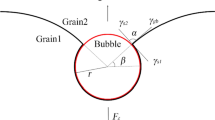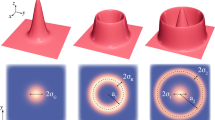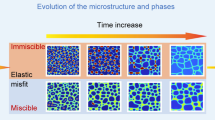Abstract
In this work, we present a multiphysics phase field model for capturing microstructural evolution during solid-state sintering processes. The model incorporates modifications of phase field equations to include rigid-body motion, elastic deformation, and heat conduction. The model correctly predicts consolidation of powder particles during sintering because of two competing mechanisms—neck formation and grain growth. The simulations show that the material undergoes three distinctive stages during the sintering process—stage I where neck or grain boundary between two particles is formed, stage II in which neck length stabilizes and growth or shrinkage of individual particles initiates, and finally stage III with rapid grain growth leading to disappearance of one of the grains. The driving forces corresponding to different mechanisms are found to be dependent on the radius of the particles, curvature at the neck location, surface energy, and grain boundary energy. In addition, variation in temperature is found to significantly influence the microstructure evolution by affecting the diffusivity and grain boundary mobility of the sintered material. The model is also used to compare sintering simulation results in 2D and 3D. It is observed that due to higher curvature in 3D, model predicts faster microstructural evolution in 3D when compared to 2D simulations under identical boundary conditions.


















Similar content being viewed by others
References
Langer J, Hoffmann MJ, Guillon O (2009) Direct comparison between hot pressing and electric field-assisted sintering of submicron alumina. Acta Mater 57(18):5454–5465
Stanciu LA, Kodash VY, Groza JR (2001) Effects of heating rate on densification and grain growth during field-assisted sintering of α-Al2O3 and MoSi2 powders. Metall Mater Trans A 32(10):2633–2638
Chaim R et al (2008) Sintering and densification of nanocrystalline ceramic oxide powders: a review. Adv Appl Ceram 107(3):159–169
Dahl P et al (2007) Densification and properties of zirconia prepared by three different sintering techniques. Ceram Int 33(8):1603–1610
Guyot P et al (2014) Hot pressing and spark plasma sintering of alumina: discussion about an analytical modelling used for sintering mechanism determination. Scripta Mater 84–85:35–38
Groza JR, Cirtis JD, Krämer M (2000) Field assisted sintering of nanocrystalline titanium nitride. J Am Ceram Soc 83(5):1281–1283
Groza JR (2000) Sintering activation by electrical field. Mater Sci Eng 287:8
Muccillo R, Muccillo ENS (2013) An experimental setup for shrinkage evaluation during electric field-assisted flash sintering: application to yttria-stabilized zirconia. J Eur Ceram Soc 33(3):515–520
Grigoryev E (2011) High voltage electric discharge consolidation of tungsten carbide - cobalt powder. In: Cuppoletti J (ed) Nanocomposites with unique properties and applications in medicine and industry. InTech
Groza JR, Garcia M, Schneider JA (2001) Surface effect in field assisted sintering. J Mater Res 16(01):286–292
Vanmeensel K et al (2005) Modelling of the temperature distribution during field assisted sintering. Acta Mater 53(16):4379–4388
Tiwari D, Basu B, Biswas K (2009) Simulation of thermal and electric field evolution during spark plasma sintering. Ceram Int 35(2):699–708
Maizza G et al (2007) Relation between microstructure, properties and spark plasma sintering (SPS) parameters of pure ultrafine WC powder. Sci Technol Adv Mater 8(7–8):644–654
Kraft T, Riedel H (2004) Numerical simulation of solid state sintering; model and application. J Eur Ceram Soc 24(2):345–361
Olevsky E, Froyen L (2006) Constitutive modeling of spark-plasma sintering of conductive materials. Scripta Mater 55(12):1175–1178
Braginsky M, Tikare V, Olevsky E (2005) Numerical simulation of solid state sintering. Int J Solids Struct 42(2):621–636
Tikare V, Braginsky M, Olevsky EA (2003) Numerical simulation of solid-state sintering: I, sintering of three particles. J Am Ceram Soc 86(1):49–53
Tikare V et al (2010) Numerical simulation of microstructural evolution during sintering at the mesoscale in a 3D powder compact. Comput Mater Sci 48(2):317–325
Bjørk R et al (2015) Modeling the microstructural evolution during constrained sintering. J Am Ceram Soc 98(11):3490–3495
Boettinger WJ et al (2002) Phase-field simulation of solidification. Annu Rev Mater Res 32(1):163–194
Loginova I, Amberg G, Agren J (2001) Phase-field simulations of non-isothermal binary alloy solidification. Acta Mater 49(4):573–581
Osório WR, Freire CMA, Garcia A (2005) Dendritic solidification microstructure affecting mechanical and corrosion properties of a Zn4Al alloy. J Mater Sci 40(17):4493–4499. https://doi.org/10.1007/s10853-005-0852-z
Uehara T, Tsujino T (2005) Phase field simulation of stress evolution during solidification. J Cryst Growth 275(1–2):e219–e224
Grafe U et al (2000) Simulations of the initial transient during directional solidification of multicomponent alloys using the phase field method. Modell Simul Mater Sci Eng 8(6):871–879
Hu S, Henager CH Jr (2009) Phase-field modeling of void lattice formation under irradiation. J Nucl Mater 394(2–3):155–159
Hu SY, Henager CH Jr (2010) Phase-field simulation of void migration in a temperature gradient. Acta Mater 58(9):3230–3237
Li Y et al (2011) Phase-field modeling of void evolution and swelling in materials under irradiation. Sci China Phys Mech Astron 54(5):856–865
Millett PC et al (2011) Phase-field simulation of irradiated metals: part I: void kinetics. Comput Mater Sci 50(3):949–959
Millett PC et al (2009) Void nucleation and growth in irradiated polycrystalline metals: a phase-field model. Modell Simul Mater Sci Eng 17(6):064003
Millett PC, Tonks M (2011) Application of phase-field modeling to irradiation effects in materials. Curr Opin Solid State Mater Sci 15(3):125–133
Ahmed K et al (2014) Phase field simulation of grain growth in porous uranium dioxide. J Nucl Mater 446(1–3):90–99
Anderson MP et al (1984) Computer simulation of grain growth—I. Kinetics. Acta Metall 32(5):783–791
Kazaryan A et al (2000) Generalized phase-field model for computer simulation of grain growth in anisotropic systems. Phys Rev B 61(21):14275–14278
Tikare V, Holm EA (1998) Simulation of grain growth and pore migration in a thermal gradient. J Am Ceram Soc 81(3):480–484
Wang YU (2006) Computer modeling and simulation of solid-state sintering: a phase field approach. Acta Mater 54(4):953–961
Deng J (2012) A phase field model of sintering with direction-dependent diffusion. Mater Trans 53(2):385–389
Ahmed K et al (2013) Phase field modeling of the effect of porosity on grain growth kinetics in polycrystalline ceramics. Modell Simul Mater Sci Eng 21(6):065005
Chanthapan S et al (2012) Sintering of tungsten powder with and without tungsten carbide additive by field assisted sintering technology. Int J Refract Metal Hard Mater 31:114–120
Biswas S et al (2016) A study of the evolution of microstructure and consolidation kinetics during sintering using a phase field modeling based approach. Extreme Mech Lett 7:78–89
Gaston DR, Peterson JW, Permann CJ, Andrš D, Slaughter AE, Miller JM (2014) Continuous integration for concurrent computational framework and application development. J Open Res Softw 2(1):e10. https://doi.org/10.5334/jors.as
Gaston D et al (2009) MOOSE: A parallel computational framework for coupled systems of nonlinear equations. Nucl Eng Des 239(10):1768–1778
Tonks M, Gaston D, Millett P, Andrš D, Talbot P (2012) An object-oriented finite element framework for multiphysics phase field simulations. Comput Mater Sci 51(1):20–29
Novascone SR et al (2015) Evaluation of coupling approaches for thermomechanical simulations. Nucl Eng Des 295:910–921
Tonks MR et al (2016) Development of a multiscale thermal conductivity model for fission gas in UO2. J Nucl Mater 469:89–98
Moelans N, Blanpain B, Wollants P (2008) An introduction to phase-field modeling of microstructure evolution. Calphad 32(2):268–294
Verma D et al (2016) Relating interface evolution to interface mechanics based on interface properties. JOM 69(1):30–38
Kumar V, Fang ZZ, Fife PC (2010) Phase field simulations of grain growth during sintering of two unequal-sized particles. Mater Sci Eng, A 528(1):254–259
Zhang R-J et al (2014) Thermodynamic consistent phase field model for sintering process with multiphase powders. Trans Nonferrous Met Soc China 24(3):783–789
Permann CJ et al (2016) Order parameter re-mapping algorithm for 3D phase field model of grain growth using FEM. Comput Mater Sci 115:18–25
Khachaturyan A-G (1983) Theory of structural transformations in solids. Wiley, Hoboken
Hu SY, Chen LQ (2001) A phase-field model for evolving microstructures with strong elastic inhomogeneity. Acta Mater 49(11):1879–1890
Yongsheng L et al (2014) Effects of temperature gradient and elastic strain on spinodal decomposition and microstructure evolution of binary alloys. Modell Simul Mater Sci Eng 22(3):035009
Tonks M et al (2010) Analysis of the elastic strain energy driving force for grain boundary migration using phase field simulation. Scripta Mater 63(11):1049–1052
Zhang L et al (2013) A quantitative comparison between and elements for solving the Cahn–Hilliard equation. J Comput Phys 236:74–80
Grujicic M, Zhao H, Krasko GL (1997) Atomistic simulation of Sigma 3 (111) grain boundary fracture in tungsten containing various impurities. Int J Refract Metal Hard Mater 15(5–6):341–355
Lassner E, Schubert W-D (1999) Tungsten: properties, chemistry, technology of the element, alloys, and chemical compounds. Springer, New York
Johnson RA (1982) Point-defect calculations for tungsten. Phys. Rev. B 27(4):2014–2018
Lee JS, Minkwitz C, Herzig C (1997) Grain boundary self-diffusion in polycrystalline tungsten at low temperatures. Phys Stat Sol 202:931–940
Kumar V (2011) Simulations and modeling of unequal sized particles sintering. In: Department of metallurgical engineering. The University of Utah
Schwen D et al (2017) Rapid multiphase-field model development using a modular free energy based approach with automatic differentiation in MOOSE/MARMOT. Comput Mater Sci 132:36–45
Millett PC et al (2012) Phase-field simulation of intergranular bubble growth and percolation in bicrystals. J Nucl Mater 425(1–3):130–135
Chen L-Q (2002) Phase-field models for microstructure evolution. Annu Rev Mater Res 32(1):113–140
Cahn JW, Hilliard JE (1958) Free energy of a nonuniform system. I. Interfacial free energy. J Chem Phys 28(2):258–267
Gao Z et al (2012) Kinetics of densification and grain growth of pure tungsten during spark plasma sintering. Metall Mater Trans B 43(6):1608–1614
Acknowledgements
We acknowledge the funding received from DoE-NETL supporting this research work. We are grateful to the MOOSE developers, especially Cody Permann and Michael Tonks, and the user community for helping with technical discussions to overcome modeling hurdles.
Author information
Authors and Affiliations
Corresponding author
Rights and permissions
About this article
Cite this article
Biswas, S., Schwen, D. & Tomar, V. Implementation of a phase field model for simulating evolution of two powder particles representing microstructural changes during sintering. J Mater Sci 53, 5799–5825 (2018). https://doi.org/10.1007/s10853-017-1846-3
Received:
Accepted:
Published:
Issue Date:
DOI: https://doi.org/10.1007/s10853-017-1846-3




